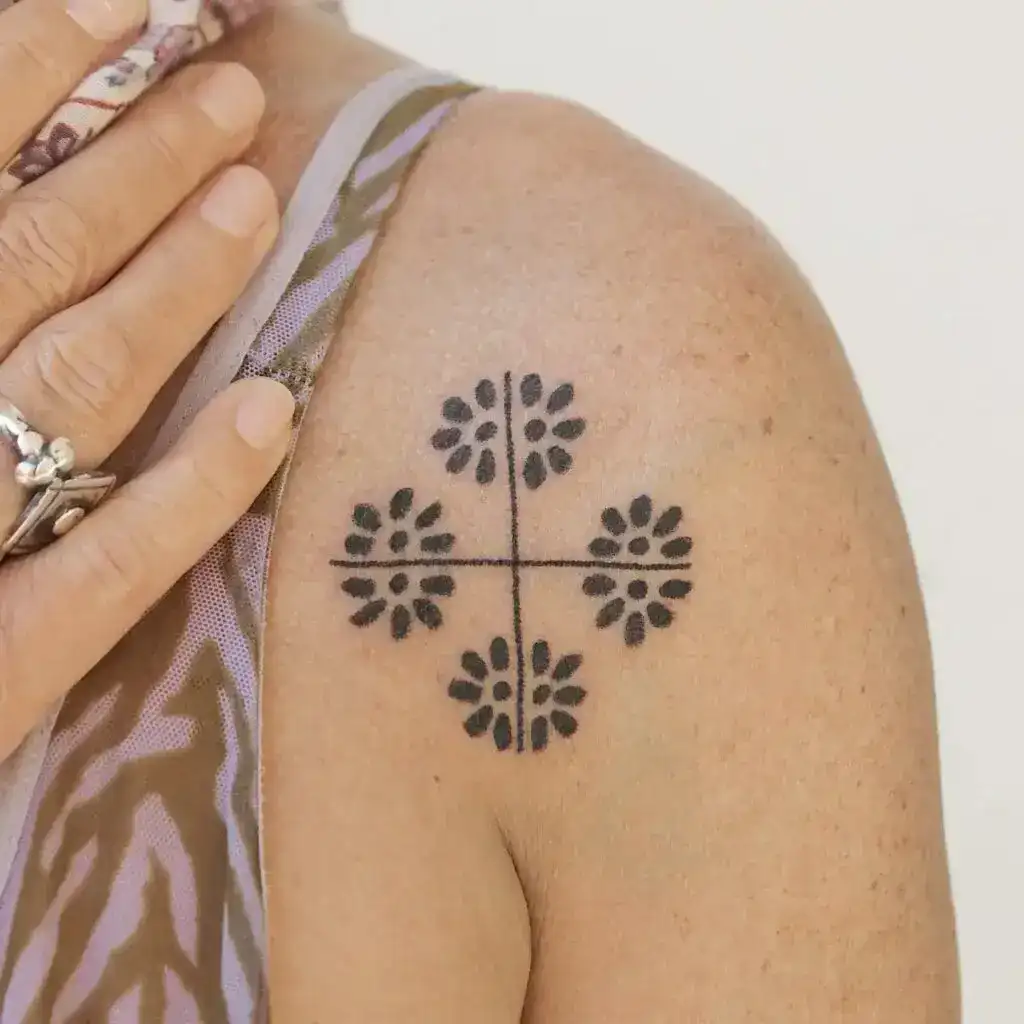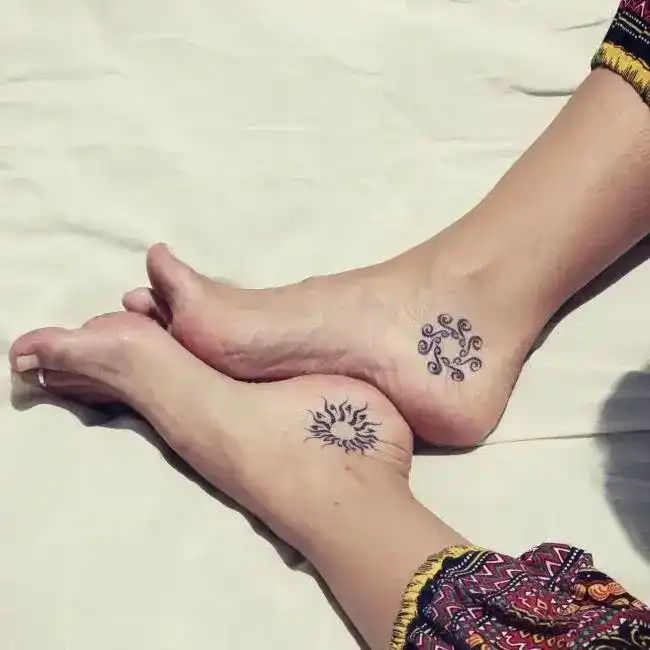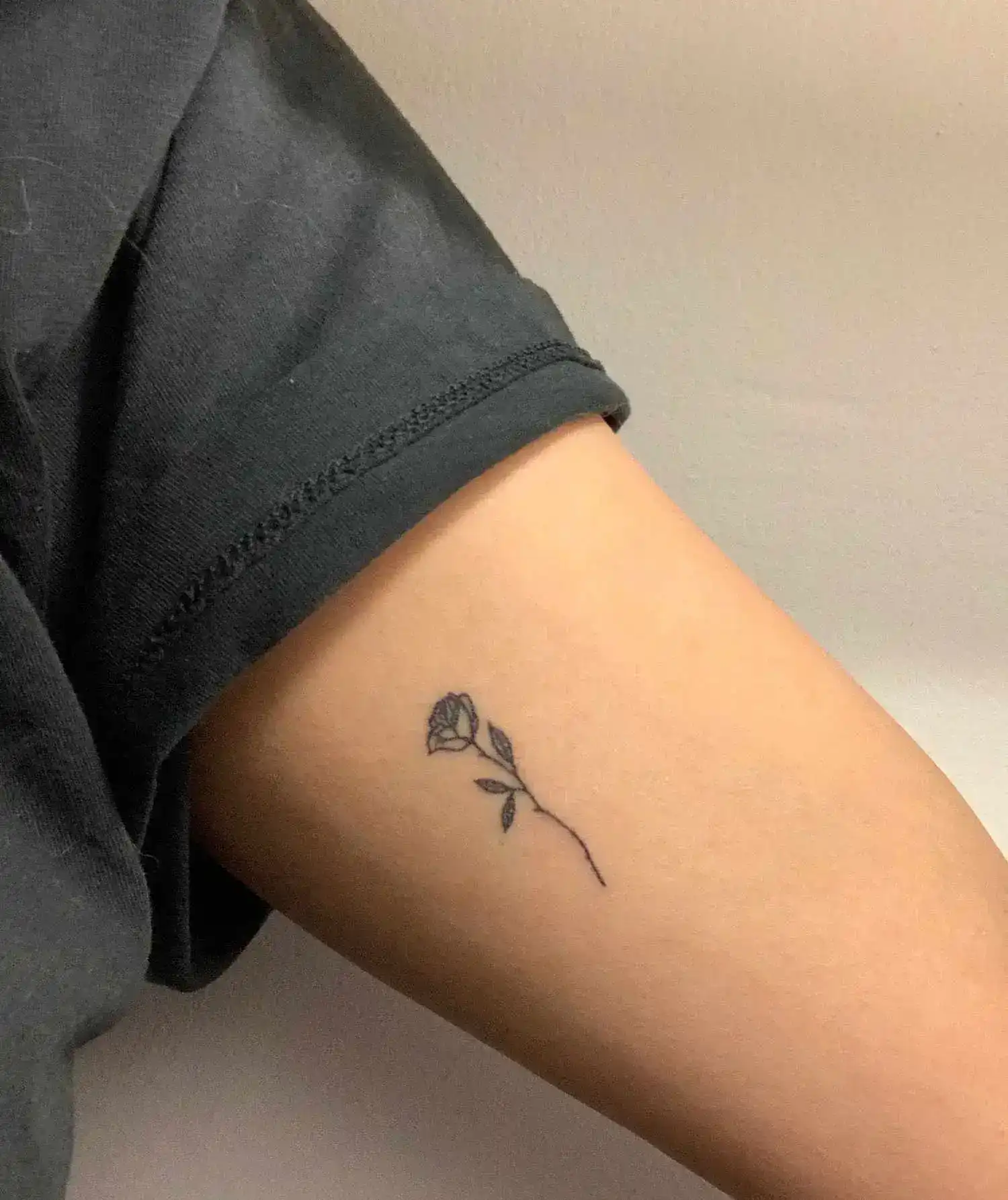In recent years, the art of stick and poke tattoos has surged in popularity. These handmade, machine-free tattoos, crafted with nothing more than a needle and some ink, are celebrated for their raw appearance and uniqueness.
Unlike their machine-made counterparts, stick and poke tattoos offer a creative expression that holds a special place in the tattoo community.
However, as we dive into the world of DIY-ing these tattoos, the question of alternatives to traditional tattoo ink arises.
It’s essential to emphasize that while exploring stick and poke ink alternatives, safety should never be compromised.
Despite their appeal, these alternatives are not always recommended by professionals, as the outcome can vary and sometimes lead to toxic effects, harmful skin irritation, tissue damage, infection, or contamination.
Given the hand-poked method’s nature, which eschews professional training and equipment, finding real alternatives that avoid the adverse effects while still delivering the desired effect is crucial.
The DIY approach, while appealing for its character and uniqueness, demands a cautious exploration of ink alternatives.
Whether for purposes of accessibility, cost, or personal preference, the alternatives explored should be approached with a clear understanding of their potential impacts.
This article, informed by personal experience and a deep dive into the community’s wisdom, aims to shed light on alternatives that respect the art’s design and expression without sidelining safety.
Also Read: What Ink To Use For Stick And Poke
7 Best Stick And Poke Ink Alternatives For Tattoos
When it comes to stick and poke tattoos, finding the best ink alternatives is crucial for both the health of your skin and the longevity of the tattoo.
We must emphasize that professional training and a sterilized environment are paramount; thus, we do not recommend using alternatives that could pose harm or lead to serious skin irritation, tissue damage, infection, or contamination.
The outcome of using non-traditional inks varies, and some can be potentially toxic.
Despite the appeal of hand-poking your own designs, the risks associated with unsterilized inks and environments should not be underestimated.
Also Read: What To Wear When Getting A Hip Tattoo

1. India Ink
Among the alternatives, India ink stands out as a popular and relatively safer option for DIY stick and poke tattoos.
It’s cheap, considered non-toxic, and more accessible than professional tattoo inks, making it a suitable choice for those attempting their first tattoo.
However, it’s important to acknowledge the downsides: tattoos done with India ink may fade over time and are not truly permanent.
For those seeking a darker and more durable option, Speedball Super Black India Ink offers an excellent payoff and is known to withstand fading to a degree greater than other India inks.
Yet, the point of using India ink means understanding its limitations, especially in terms of application issues and the long-term appearance of the tattoo.
2. Pen Ink
Using pen ink for DIY stick and poke tattoos might seem like a convenient and popular idea, but it’s essential to consider the risks.
Pen ink is not produced for use on the skin; it’s meant for writing. The notion that it’s a safe alternative for tattooing overlooks the potential for contamination and infection at the tattoo site.
You’re risking serious tissue damage, as pen inks are not sterile and can be toxic to the body. Historically, pen ink has been used in prison tattoos under circumstances where people had no other options.
However, outside those cases, with the issues of safety and health, it’s hard to recommend it as a viable alternative for tattoo enthusiasts.
Also Read: How Does Tattoo Removal Work
3. Sharpie Ink
Sharpie ink is another popular choice for creating non-permanent tattoos on arms and hands.
The marker’s ink is designed for drawing and thus carries a decent payoff when used to create stick and poke tattoos.
However, despite some claims, Sharpie ink is not an ideal alternative. While it may work for temporary designs, the ink is considered toxic to an extent if pushed into the skin.
This can lead to issues with fading quickly and terrible detail retention. The tattoos often look done hastily and lose their looks rapidly.
Even though Sharpie ink may seem like a regular option for those seeking alternatives, its toxicity and the problem of fading make it less recommendable for serious tattooing.
4. BIC Pen Ink
When exploring alternative options for stick and poke tattoos, BIC pen ink often surfaces as a popular choice.
Its widespread availability and the range of colors it offers make it an attractive option for those venturing into the realm of body art.
From my personal experience dabbling in arts and crafts, BIC pen ink, being oil-based, provides a certain detail and color retention that is hard to find in other makeshift inks.
However, it’s crucial to note that despite its non-toxic rating for surface applications, when injected under the skin, the larger particles typically found in pen ink can pose significant health hazards.
The majority of medical professionals and tattoo artists would not recommend using BIC pen ink due to these issues.
Modern laser treatments, while advanced, may find it hard to break down and remove these particles, requiring more sittings, time, and cost than needed. This is a stark reminder that what works for paper might not be suitable for skin.
Also Read: Will Laser Tattoo Removal Damage My Skin? Get The Facts
5. Pencil Graphite
Pencil graphite is another ink alternative that has gained popularity, especially within prison tattoos, for pushing graphite under the skin to create body art.
This method might seem like a good idea for those seeking a DIY approach to tattoos, but the major concern here is the terrible color retention and the risk of toxicity.
Graphite, unlike traditional tattoo inks, tends to show up poorly on the skin, often resulting in tattoos that look faded or blurred.
Additionally, the body often rejects these foreign particles, making tattoo removal a more complex process.
Laser treatments may not work as effectively to break down and dissipate the graphite within the tissue, making it hard to get rid of the tattoo completely.
Based on my experience, while it’s a popular choice due to its accessibility, I would bear in mind the potential health risks and long-term issues before recommending pencil graphite as a viable alternative for stick and poke tattoos.
6. Food Coloring
Food coloring is rarely used as an alternative for stick and poke ink, but it’s an idea worth trying if you’re looking for something different.
However, the skin might not show the tattoo properly, and there’s a high chance the body will reject it.
Despite being one of the safest options due to the lack of toxic ingredients commonly found in traditional tattoo inks, medical professionals and tattoo artists express concerns over its detail retention and safety.
There’s controversial debate in the community about the adverse effects seen in laboratory animals, suggesting these dyes are inadequately tested for skin application.
My favorite professional artist advises caution, reflecting on patients who experienced issues with tattoos using such unconventional ink alternatives.
Also Read: How To Remove Tattoos At Home With 13 Proven Methods
7. Eyeliner
Considering eyeliner as a final ink alternative might seem appealing due to its regular accessibility and pigmented nature, making one think it’s perfect for stick and poke tattoos.
The truth, however, is that the body’s rejection rate is surprisingly high, leading to scabbing and a messed-up design.
Detail retention is terrible, and despite eyeliner being safe for external use, its toxicity levels haven’t been cleared for internal, within-the-skin applications.
My experience echoes the broader sentiment: makeup products, while accessible and tempting, pose significant risks when repurposed for body art.

Tattoo The Right Way
Embarking on the DIY route for stick-and-poke tattoos at home makes your body a personal canvas for art that tells your life story.
However, achieving a look that’s not only good but also safe and healthy, necessitates careful selection of ink.
There’s a reason professional tattoo artists meticulously choose specific inks: they’re formulated for skin, tested over time, and come with a variety of options to suit any design or health concern.
Here’s a best practices guide for ink alternatives:
- Black Standard Ink: The standard choice for its deep, pigmented, and durable nature.
- Vegan Inks: These inks avoid animal products and byproducts, aligning with a healthy lifestyle and organic principles.
- Medical-Grade Inks: Adhere to the highest health and safety standards, being sterile and hypoallergenic to minimize risks of infection and allergic reactions.
- Temporary Inks: For those hesitant to commit to a permanent mark, these inks offer a design that lasts for weeks but can tell a part of your story without the long-term commitment.
Aftercare is a critical part of the tattoo process, where licensed professional artists play a pivotal role.
They not only use sterile equipment but also provide detailed aftercare instructions to ensure the tattoo heals properly, preventing infection and maintaining the design’s integrity.
Your body art is more than décor; it’s a road to expressing your identity, with health and safety as the number one priority.
Also Read: What Are The Long Term Effects Of Tattooing Your Body
FAQs About Stick And Poke Ink Alternatives
1. What Ink Can I Use For Stick And Poke At Home?
For those venturing into stick and poke tattoos at home, India ink is a tried-and-true option. Unlike fashioned gun pen or sewing needles which might not stand the test of time, India ink has lasted years without giving a horrible look. It’s essential to aim for a good aesthetic with reliable materials.
2. What Is The Best Non-Toxic Pen Ink For Stick And Poke?
The best non-toxic pen inks for stick and poke tattoos include brands like India, Higgins, Speedball, and Winsor & Newton. These are easily available on the internet and offer a safer alternative to traditional tattoo inks, ensuring your DIY tattoo looks great and lasts.
3. Can I Use Pen Ink For A Stick And Poke?
While pen ink can technically be used for stick and poke tattoos, it’s not advisable. Pen inks can be toxic, containing dyes and chemicals including carcinogens. To stay on the safe side, opt for tattoo-grade ink or non-toxic alternatives to avoid allergic reactions.
4. What Other Ink Can You Use For Stick And Poke?
Aside from India ink, Higgins, Speedball, and Winsor & Newton are some of the best non-toxic inks for stick and poke tattoos. These options are easily available on the internet and are safer than pen inks, which can contain toxic substances.
5. What Can I Substitute For Tattoo Ink?
For a substitute for tattoo ink, consider wood ashes mixed with white liquor, creating an organic, cheap, and sterile pigment. Medical-grade liquids can also mimic tattoo ink, offering a safe alternative recommended by artists and tattoo shops.
6. What Ink Can Be Used As Tattoo Ink?
Ink used as tattoo ink can range from industrial to organic, mineral, vegetable-based, plastic-based, and metallic elements in their composition. These provide diverse options for both traditional and stick and poke tattoos.
7. Is Eyeliner Ink Safe For Stick And Poke?
Eyeliner ink, while safe for surface skin application, may not be ideal for stick and poke tattoos. It can fade or completely disappear, depending on how deep or shallow it’s applied, due to its thickness and formulation for temporary wear.
8. Can You Use Eyeliner As Tattoo Ink?
Eyeliner is not specifically designed for tattoo ink use and may not be sterile, posing health problems such as infections, allergic reactions, and scarring. Always consider health and safety when choosing tattoo materials.
9. Is Ballpoint Pen Ink Safe For Tattoos?
Ballpoint pen ink is predominantly dye-based, making it not safe for tattoos. Its color is dissolved in water-soluble carriers that the body can flush out, causing the design to blur and fade quickly.
Final Thoughts
In summary, exploring stick and poke ink alternatives highlights a crucial balance between creativity and safety in the realm of DIY tattoos.
The key takeaway is the importance of choosing inks that not only ensure your tattoo looks good and lasts a lifetime but also minimizes health risks such as toxicity, tissue damage, skin irritation, and infection.
Brands like India, Higgins, Speedball, and Winsor & Newton come highly recommended for their non-toxic formulations, proving safer than traditional pen ink or homemade concoctions which can be harmful.
Moreover, understanding that even the best alternatives can be rejected by the body underscores the necessity of applying them in a sterilized, controlled environment with professional tools.
Knowledge about what you’re doing not only minimizes risks but ensures your body art remains a source of pride rather than a cause for concern.
This comprehensive approach to stick and poke ink alternatives insists on an informed decision-making process, emphasizing health and safety over convenience or cost.
